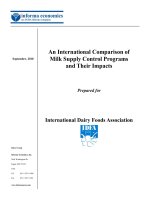Sense and Respond Logistics - Integrating Prediction, Responsiveness, and Control Capabilities pot
Bạn đang xem bản rút gọn của tài liệu. Xem và tải ngay bản đầy đủ của tài liệu tại đây (657.59 KB, 134 trang )
This document and trademark(s) contained herein are protected by law
as indicated in a notice appearing later in this work. This electronic
representation of RAND intellectual property is provided for non-
commercial use only. Permission is required from RAND to reproduce, or
reuse in another form, any of our research documents.
Limited Electronic Distribution Rights
Visit RAND at www.rand.org
Explore RAND Project AIR FORCE
View document details
For More Information
This PDF document was made available
from www.rand.org as a public service of
the RAND Corporation.
6
Jump down to document
THE ARTS
CHILD POLICY
CIVIL JUSTICE
EDUCATION
ENERGY AND ENVIRONMENT
HEALTH AND HEALTH CARE
INTERNATIONAL AFFAIRS
NATIONAL SECURITY
POPULATION AND AGING
PUBLIC SAFETY
SCIENCE AND TECHNOLOGY
SUBSTANCE ABUSE
TERRORISM AND
HOMELAND SECURITY
TRANSPORTATION AND
INFRASTRUCTURE
WORKFORCE AND WORKPLACE
The RAND Corporation is a nonprofit
research organization providing
objective analysis and effective
solutions that address the challenges
facing the public and private sectors
around the world.
Purchase this document
Browse Books & Publications
Make a charitable contribution
Support RAND
This product is part of the RAND Corporation monograph series.
RAND monographs present major research findings that address the
challenges facing the public and private sectors. All RAND mono-
graphs undergo rigorous peer review to ensure high standards for
research quality and objectivity.
Robert S. Tripp, Mahyar A. Amouzegar, Ronald G. McGarvey,
Rick Bereit, David George, Joan Cornuet
Prepared for the United States Air Force
Approved for public release; distribution unlimited
Sense and
Respond Logistics
Integrating Prediction, Responsiveness,
and Control Capabilities
The RAND Corporation is a nonprofit research organization providing
objective analysis and effective solutions that address the challenges
facing the public and private sectors around the world. RAND’s
publications do not necessarily reflect the opinions of its research clients
and sponsors.
R
®
is a registered trademark.
© Copyright 2006 RAND Corporation
All rights reserved. No part of this book may be reproduced in any
form by any electronic or mechanical means (including photocopying,
recording, or information storage and retrieval) without permission in
writing from RAND.
Published 2006 by the RAND Corporation
1776 Main Street, P.O. Box 2138, Santa Monica, CA 90407-2138
1200 South Hayes Street, Arlington, VA 22202-5050
4570 Fifth Avenue, Suite 600, Pittsburgh, PA 15213-2665
RAND URL: />To order RAND documents or to obtain additional information, contact
Distribution Services: Telephone: (310) 451-7002;
Fax: (310) 451-6915; Email:
Cover photo courtesy of the Integrator
The research reported here was sponsored by the United States Air
Force under Contract F49642-01-C-0003. Further information may be
obtained from the Strategic Planning Division, Directorate of Plans, Hq
USAF.
Library of Congress Cataloging-in-Publication Data
Tripp, Robert S., 1944–
Sense and respond logistics : integrating prediction, responsiveness, and control
capabilities / Robert S. Tripp, Mahyar A. Amouzegar, [et al.].
p. cm.
“MG-488.”
Includes bibliographical references.
ISBN-13: 978-0-8330-3978-1 (pbk. : alk. paper)
1. United States. Air Force—Supplies and stores. 2 Command and control
systems—United States. 3. Airlift, Military—United States. 4. Deployment
(Strategy) I. Amouzegar, Mahyar A. II. McGarvey, Ronald G. III. Title.
UG1103.T75 2006
358.4'1411—dc22
2006024048
Preface
is monograph discusses U.S. Air Force progress toward implement-
ing sense and respond logistics (S&RL) or, as defined more broadly in
this monograph, sense and respond combat support (S&RCS). As the
United States and the Department of Defense transition current forces
to a fighting force tailored to the new challenges of the 21st century,
responsiveness and flexibility have become fundamental qualities in
operational and support forces. Combat support (CS) personnel have
traditionally not been integrated into the operational planning cycle
and have developed support plans only after the operational plan has
been established. To succeed in their task of supplying essential sup-
port materials to operational forces engaged in combat or humanitar-
ian missions, CS forces developed consumption formulas and models,
based on relatively long supply chains, that often failed to accurately
predict support needs. To compensate for possible deficiencies in the
estimates and the relatively long resupply times, they sent “mountains
of supplies” to the war zone to ensure that there would be enough
materiel to cover the resupply times.
ese “just-in-case” approaches have been noted by the military,
and more responsive and adaptive approaches have been the subject of a
good deal of study. is monograph describes some of the research that
has been conducted on the military CS system, focusing on improve-
ments in prediction capabilities, responsiveness of supply chains, and
a governing command and control system. Progress has been made
in all three areas, and these results have improved Air Force ability to
respond to the unique challenges of national defense in the new cen-
iii
iv Sense and Respond Logistics
tury. Even so, much remains to be done in the transformation of Air
Force CS processes to meet the requirements needed to enable S&RCS
capabilities.
is monograph tracks this progress, explains the challenges, and
plots critical requirements to develop an effective system—one that
senses what is happening on the battlefield and responds to actual
requirements rapidly.
e research reported here was sponsored by the Deputy Chief
of Staff for Installations and Logistics, U.S. Air Force (A4/7, formerly
AF/IL), and conducted within the Resource Management Program of
RAND Project AIR FORCE. It should be of interest to logisticians,
operators, and planners throughout the Department of Defense, espe-
cially those in the Air Force.
is monograph is one of a series of RAND Corporation reports
that address agile combat support (ACS) options. Other publications
issued as part of the Supporting Air and Space Expeditionary Forces
series include the following:
An Integrated Strategic Agile Combat Support Planning Framework,
Robert S. Tripp, Lionel A. Galway, Paul S. Killingsworth, et al.
(MR-1056-AF). is report describes an integrated combat sup-
port planning framework that may be used to evaluate support
options on a continuing basis, particularly as technology, force
structure, and threats change.
New Agile Combat Support Postures, Lionel A. Galway, Robert S.
Tripp, et al. (MR-1075-AF). is report describes how alterna-
tive resourcing of forward operating locations (FOLs) can support
employment timelines for future Air and Space Expeditionary
Forces (AEF) operations. It finds that rapid employment for
combat requires some prepositioning of resources at FOLs.
An Analysis of F-15 Avionics Options, Eric Peltz et al. (MR-1174-
AF). is report examines alternatives for meeting F-15 avionics
maintenance requirements across a range of likely scenarios. e
authors evaluate investments for new F-15 Avionics Intermediate
Shop test equipment against several support options, including
•
•
•
deploying maintenance capabilities with units, performing main-
tenance at forward support locations (FSLs), and performing all
maintenance at the home station for deploying units.
A Concept for Evolving to the Agile Combat Support/Mobility System
of the Future, Robert S. Tripp, Lionel A. Galway, Timothy L.
Ramey, et al. (MR-1179-AF). is report describes the vision for
the ACS system of the future based on individual commodity
study results.
Expanded Analysis of LANTIRN Options, Amatzia Feinberg et
al. (MR-1225-AF). is report examines alternatives for meet-
ing Low Altitude Navigation and Targeting Infrared for Night
(LANTIRN) support requirements for AEF operations. e
authors evaluate investments for new LANTIRN test equipment
against several support options, including deploying maintenance
capabilities with units, performing maintenance at FSLs, or per-
forming all maintenance at support hubs in the Continental
United States for deploying units.
Alternatives for Jet Engine Intermediate Maintenance, Mahyar A.
Amouzegar, Lionel A. Galway, and Amanda Geller (MR-1431-
AF). is report evaluates the manner in which Jet Engine
Intermediate Maintenance (JEIM) shops can best be configured
to facilitate overseas deployments. e authors examine a number
of JEIM support options, which are distinguished primarily by
the degree to which JEIM support is centralized or decentral-
ized. See also Engine Maintenance Systems Evaluation (Enmasse):
A User’s Guide, Mahyar A. Amouzegar and Lionel A. Galway
(MR-1614-AF).
An Operational Architecture for Combat Support Execution Planning
and Control, James Leftwich et al. (MR-1536-AF). is report
outlines the framework for evaluating options for combat sup-
port execution planning and control. e analysis describes the
combat support command and control operational architecture
as it is now and as it should be in the future. It also describes the
changes that must take place to achieve that future state.
Reconfiguring Footprint to Speed Expeditionary Aerospace Forces
Deployment, Lionel A. Galway, Mahyar A. Amouzegar, et al.
•
•
•
•
•
Preface v
(MR-1625-AF). is report develops an analysis framework—as
a footprint configuration—to assist in devising and evaluating
strategies for footprint reduction. e authors attempt to define
footprint and to establish a way to monitor its reduction.
Analysis of Maintenance Forward Support Location Operations,
Amanda Geller et al. (MG-151-AF). is monograph discusses
the conceptual development and recent implementation of main-
tenance forward support locations (also known as centralized
intermediate repair facilities [CIRFs]) for the U.S. Air Force.
e analysis focuses on the years leading up to and including the
A4/7 (formerly AF/IL) CIRF test, which tested the operations of
centralized intermediate repair facilities in the European theater
from September 2001 to February 2002.
Lessons from Operation Enduring Freedom, Robert S. Tripp, Kristin
F. Lynch, et al. (MR-1819-AF). is report analyzes combat sup-
port experiences associated with Operation Enduring Freedom
and compares them with those associated with Operation Allied
Force.
Analysis of Combat Support Basing Options, Mahyar A. Amouzegar,
Lionel A. Galway, and Robert S. Tripp (MG-261-AF). is
monograph presents an analytical framework for evaluating alter-
native FSL options. A central component of this work is an opti-
mization model that allows a user to select the best mix of land-
based and sea-based FSLs for a given set of operational scenarios,
thereby reducing costs while supporting a range of contingency
operations.
RAND Project AIR FORCE
RAND Project AIR FORCE (PAF), a division of the RAND
Corporation, is the Air Force’s federally funded research and develop-
ment center for studies and analyses. PAF provides the Air Force with
independent analyses of policy alternatives affecting the development,
employment, combat readiness, and support of current and future
aerospace forces. Research is conducted in four programs: Aerospace
•
•
•
vi Sense and Respond Logistics
Force Development; Manpower, Personnel, and Training; Resource
Management; and Strategy and Doctrine.
Additional information about PAF is available on our Web site at
/>Preface vii
Contents
ix
Preface iii
Figures
xiii
Tables
xv
Summary
xvii
Acknowledgments
xxiii
Abbreviations
xxv
CHAPTER ONE
Introduction 1
e Air and Space Expeditionary Force Construct
2
An Expeditionary Force Requires Agile Combat Support
2
CSC2: An Important Part of ACS and Enabler of S&RCS
6
A New Vision
8
Defining Sense and Respond Combat Support
10
A Military Idea Turned Commercial
12
Organization of is Monograph
13
CHAPTER TWO
e CSC2 Operational Architecture 15
e USAFE Centralized Intermediate Repair Facility—A Recent
Example
16
High-Level CSC2 Processes
17
Feedback Loops
18
Continuous Monitoring of Important Parameters
20
Continuously Updated Data Systems Are Needed
21
x Sense and Respond Logistics
Standing Combat Support Organizations 24
Commander of the Air Force Forces Staff Forward and Rear
24
Logistics Support Centers
25
Commodity Control Points
25
Combat Support Center
27
Estimating and Budgeting for Requirements
27
e Planning Processes
28
Deliberate Planning
28
Crisis Action Planning
31
e Programming and Budgeting Processes
31
e Role of Commodity Control Points in Budgeting
32
e Execution Processes
33
Deployment
33
Employment/Sustainment
34
Capability Assessment and Reporting
34
Assessing Performance Shortfalls
35
Information Security and the Access to Information
36
CHAPTER THREE
Tools and Technology Requirements for Sense and Respond
Combat Support
37
e Office of Force Transformation Program
38
Sense and Respond Technical Requirements
40
Radio Frequency Identification
41
Software Agents and Agent-Based Modeling
43
What Is an Agent?
43
Agent-Based Modeling
45
Applications of Agents and Agent-Based Modeling
45
Exploring Sensitivity to Assumptions and Random Variations
in Behavior
47
Exploring Cooperation and Competition in Organizations
47
Agent-Based Modeling for Sense and Respond Logistics
48
DoD S&RL Initiatives
49
DARPA Research and Development
50
S&RL Demonstration—U.S. Army
51
Coalition Agent eXperiment
51
Contents xi
Map Aware Non-Uniform Automata 52
S&RL Information Technology Prototype
52
Human Factor Aspects of S&RL
54
Autonomic Logistics
55
Commercial and University Initiatives
56
IBM Sense and Respond Programs and Technology
56
General Electric
57
SAP
58
General Motors OnStar
®
59
Robotics Institute—Carnegie Mellon University
60
Agent Technology Today and Tomorrow
61
CHAPTER FOUR
Air Force CSC2 Implementation Effort 65
Status of Implementation Actions
66
C2 Doctrine
66
Organizations and Processes
67
Operations Support Centers
67
Commodity Control Points
68
Combat Support Center
68
Training
69
Information Systems
69
Enterprise-Wide Systems and Combat Support Command and
Control
72
Closed-Loop Planning and Control Systems
73
CSC2 Concepts Are Being Evaluated in Exercises
74
Future Work to Implement TO-BE CSC2 Operational
Architecture
75
CHAPTER FIVE
Future Work and Challenges 77
Dynamic Feedback—e Foundation for S&RCS
78
Planning
79
Directing
81
Coordinating
83
Controlling
84
xii Sense and Respond Logistics
Information Systems and Decision Support Tools 85
New Sense and Respond Systems
86
Agents and Related Technology
87
Toward a Responsive System
89
Bibliography
93
Figures
xiii
2.1. Combat Support Performance Parameters Are Related
to Operational Measures of Effectiveness
18
2.2. Feedback Loop Process
19
Tables
xv
1.1. Operational Effects and ACS Capabilities 4
3.1. Agent-Related Technologies for Infrastructure Support
62
xvii
Summary
Sense and respond logistics (S&RL) or, more broadly, sense and
respond combat support (S&RCS), has been the subject of much dis-
cussion. However, many of its operational components have not been
fully envisioned and both current and projected technological appara-
tus is limited. Moreover, it is not clear how these components can be
incorporated or function within a military logistics or combat system.
is monograph identifies the elements of S&RCS and shows what is
necessary to use the concept within the military, and more specifically
the Air Force, combat support system. e monograph further surveys
the state of technology necessary to implement S&RCS capabilities
within the military and identifies both the technical work that needs to
be further developed and the Air Force organization most appropriate
to manage the development of these capabilities.
Military S&RCS Defined: Integration of Predictive,
Responsiveness, and Command and Control Capabilities
S&RCS capabilities involve predicting what will be needed and respond-
ing quickly to anticipated or unanticipated needs to maintain military
capabilities. In the past, theories about prediction and responsiveness
were framed as competitive concepts. is monograph shows the need
for both predictive tools and responsive systems working together within
a combat support command and control (CSC2) framework to create
military capabilities. Although some elements of S&RCS have been
exercised throughout the Air Force’s history, years were required to
xviii Sense and Respond Logistics
develop and understand the relationship between predictive tools and
responsive logistics management and processes and make it feasible to
design a responsive and adaptive combat support (CS) system able to
meet today’s and tomorrow’s defense challenges in a more effective and
efficient manner. Recently, conceptual, political, budgetary, and tech-
nological developments have converged, necessitating and permitting
the transformation from traditional logistics support policies and prac-
tices into a comprehensive agile combat support (ACS) system able
to achieve the required balance among scarce resources and improved
processes that can replace mass with speed (i.e., large numbers of assets
in place versus rapid distribution of smaller increments of resources as
they are needed or consumed). CSC2 is key to this transformation. e
Air Force vision of the CSC2 architecture and current implementa-
tion actions of that architecture are important steps in overseeing and
coordinating the complex set of support functions essential to reliable
support of military operations.
It is important to distinguish the inclusive concept of combat sup-
port from the smaller subset of logistics. e traditional, but narrower,
definition of logistics includes the disciplines of supply, maintenance,
transportation, logistics plans, munitions, and sometimes contracting.
e smaller subset is commonly referred to as logistics with a little “l”.
Combat support is sometimes referred to as logistics with a big “L”,
since it incorporates all aspects of establishing and supporting a base
of military operations. Combat support incorporates all of the little
“l” logistics areas but also civil engineering, force protection, billeting,
messing, and other services required to support a fighting force in the
field.
is monograph focuses on the larger view of logistics, which
incorporates the broader concept of all CS requirements. Blending
principles of S&RL with the broader and inclusive definition of combat
support, we have created the acronym S&RCS, which we use through-
out this study. S&RCS is an essential piece in combat support that
facilitates ACS.
The CSC2 Architecture
One contribution of this monograph is to define the relationship
between CSC2 and S&RCS. is monograph presents CSC2 as a
key enabler of S&RCS and indicates why it is necessary to implement
S&RCS in military applications. CSC2 involves the following:
Joint development of a plan (campaign, peacetime training, or
others) in which logistics process performance and resource levels
are related to desired operational effects, e.g., projected weapon
system availability, forward operating location initial operating
capability, and so forth. e development of a joint plan requires
prediction and models to translate logistics process performance
and resource levels to operationally relevant measures of effective-
ness for the plan. Draft plans are iterated until a feasible plan is
generated. ese feasibility assessments require models and pre-
dictions to determine if assumed logistics process performance
and resources allocated to the plan can meet desired operational
effects. To support rapid global deployment and employment
objectives, the Air Force has geared deployment so that fewer
resources are deployed with combat units, requiring less material
to be initially deployed and therefore allowing more rapid deploy-
ment of the unit. e Air Force then relies on responsive resupply
to support ongoing operational activities.
Establishment of logistics process performance and resource-level
control parameters that are necessary to achieve the desired oper-
ational objectives.
Execution of the plan and tracking of control parameters against
actual process performance and resource levels to achieve specific
operational effects. is is the sense part of the CSC2 system.
e system senses when deviations in logistics system perfor-
mance will affect operational performance. is is critical to mili-
tary activities. Many subsystems may not be performing as well as
they could, and yet their performance may not affect operational
•
•
•
Summary xix
xx Sense and Respond Logistics
outcomes. e system must be able to differentiate between insig-
nificant degradations in performance and CS shortfalls that will
constrain operations.
Signaling logistics process owners when their processes lie outside
control limits. When logistics performance is likely to adversely
affect operational outcomes, action is necessary to correct the
process performance or to adjust logistics resource levels to con-
form to the actual process performance, e.g., if transportation is
slower than planned, additional resource levels at the deployed
location may have to be authorized if transportation cannot be
made quicker, as may be the case in high-threat environments.
Prediction capabilities are critical here, because the aim of S&RCS
capabilities is to identify CS problems before they have a negative
effect on operational objectives.
Replan logistics or operational components of the plan to
mitigate the portions of the plan that are outside control limits.
is affects the plan and new control limits will need to be
established and the process of tracking performance continued.
is sense and respond (S&R) system then continues indefi-
nitely.
Modern CSC2 capabilities, as well as future improvements, can
be used by the Department of Defense (DoD) and the Air Force to
build an efficient system of S&RCS in and among the military ser-
vices. More significantly, today’s emerging CSC2 capabilities are facili-
tating the move to S&RCS. In the past, limits in CSC2 have prevented
a robust and systematic S&RCS capability. Today, a convergence of CS
doctrine and capability makes S&RCS possible. ese new capabili-
ties will allow the Air Force to translate operational requirements into
logistical requirements, set control parameters, sense, and respond to
out-of-control conditions. In short, the Air Force can achieve S&RCS
capabilities in the challenging military environment if it continues
along the path of upgrading the CSC2 architecture, information sys-
tems, organizations, and training of CS personnel. (See pp. 20–27.)
•
•
Technology Necessary to Create S&CS Capabilities
e DoD Office of Force Transformation (OFT) developed the military
sense and respond logistics concept, borrowing heavily from research in
the commercial sector (which was in turn indebted to earlier military
efforts) to describe an adaptive method for maintaining operational
availability of units by managing their end-to-end support network.
1
OFT identified a number of technologies that are needed to produce an
S&RL capability, two of which were highlighted as especially impor-
tant components: radio frequency identification (RFID) and intelli-
gent (adaptive) software agents. RFID is an Automatic Identification
Technology (AIT) that provides location and status information for
items in the CS system. RFID technologies are fairly mature and have
been fielded in both commercial and military arenas.
Agent-based modeling allows a more robust simulation of combat
support operations. Agent-based models (ABMs) have been used exten-
sively in combat modeling but, until very recently, there has been lim-
ited application in the logistics area. A number of initiatives developed
by the Defense Advanced Research Project Agency have examined the
use of ABMs in the CS domain; however, these technologies are still in
their early stages.
is monograph summarizes a number of key DoD and commer-
cial initiatives to implement S&RL technologies and identifies a prom-
ising DoD trial (OFT’s S&RL Information Technology prototype)
along with one successfully fielded commercial system (developed by
General Electric Transportation Systems). However, an important con-
clusion of this review is that although current technology has enabled
a limited set of sense and respond capabilities, a full implementation
of S&RL concepts remains dependent on substantial future techno-
logical development. e largest challenge ahead for implementing a
broader S&RCS capability is the development of an understanding
of the interactions between combat support system performance and
combat operational metrics. (See p. 37.)
1
U.S. DoD (2003).
Summary xxi
xxii Sense and Respond Logistics
An Implementation Path for Creating Air Force S&RCS
Capabilities
e Air Force has already begun to take steps to implement some of
these concepts and technologies with varying degrees of success. Air
Force implementation actions include making doctrine changes to rec-
ognize the importance of CSC2, as part of S&RCS capabilities, and
identifying training and information system improvements.
In addition, the Air Force should identify one organization to lead
development of CSC2 and associated S&RCS capabilities. is would
facilitate the development of these capabilities. Currently, the Air Force
Command and Control Intelligence, Surveillance, and Reconnaissance
Center (AFC2ISRC) is tasked with developing and testing C2 tools.
e AFC2ISRC has an A4 (logistics) staff element that could exer-
cise responsibility for developing and leveraging existing CSC2 and
S&RCS tools under the AFC2ISRC charter. is lead role would need
to be supported by the AFC2ISRC/CC and A4/7 (formerly AF/IL) and
the AFC2ISRC mission statement might need to be revised to empha-
size the importance of the CSC2 and S&RCS development responsi-
bility. Staffing levels to accomplish the new responsibilities may need
to be reviewed to ensure that they are adequate to handle the added
responsibilities. (See pp. 71–72.)
xxiii
Acknowledgments
is monograph outlines the development of military sense and respond
combat support concepts, especially those developed within the U.S.
Air Force. Over the years, several people in the Air Force have sup-
ported the development of the concepts explained here. Many of them
are acknowledged in the research cited in this monograph. e senior
leaders who sponsored work in this area were people of vision who had
the patience to invest research capital in a difficult and complex field
and to wait years for payback. Many in the Air Force helped gather
data, support visits to operational and support locations, and test the
concepts before implementation of the concepts took place.
is report was sponsored by Grover Dunn, A4I (formerly AF/
ILI), Director of Innovation and Transformation. He provided the
guidance to closely link this effort to ongoing Air Force transforma-
tion efforts. Colonels Chris O’Hara, A4RX (formerly AF/ILGX), and
Paul Dunbar, A4I (formerly AF/ILI), have also been instrumental in
keeping this study closely aligned with their work with modernized
information enterprise modernization.
Many RAND researchers also contributed to this field of study
and the concepts discussed in this monograph. ey include Bernice
Brown and her colleagues in the 1950s who indicated that logistics pro-
cesses in the Air Force dealt with problems of uncertainty and, therefore,
prediction of precise logistics parameters may never be possible. ey
indicated that hedging strategies and responsive management adapta-
tions could effect changes in logistics process performance and thereby
mitigate problems associated with poor forecasting capabilities.









